1880s: We would have all booked a room at the
Swanton House
Posted on February 29, 2008 by June Morrall (This page updated 20 Jun 2025)
Sarah Swanton, Pescadero innkeeper, was praised as a woman of remarkable business ability, blessed with the friendliest personality.
“As an entertainer she has few equals and no superiors in hotel management, ” the San Mateo Times & Gazette raved in 1896.
Sarah and husband Charles Swanton ran the Swanton House Hotel for three decades, between the 1860s and 1890s, earning many return guests who appreciated the “courteous and accommodating way” they were always treated.
The Pescadero community loved the Swanton's because their well-run business brought cash into the village’s economy, the general store, the restaurant, the stables, and so on.
In fact, she kept a stable business next door to the Swanton Hotel and she hired R.K. Farley to run it, ferrying hotel guests to Pebble Beach, where entire days were spent sifting through the pebbles for a colorful one that might make a perfect pendant.
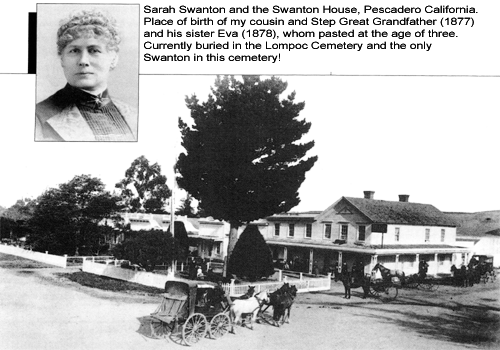
Owning the stable next door also put Sarah into direct competition with Loren Coburn, Pescadero’s least favorite citizen. Coburn also owned a stable and both Sarah and Loren depended on the tourist trade for profits. As I’ve posted many times, most visitors came to Pescadero to visit Pebble Beach, the well known hunting ground for beautiful “gems.” Horse-and-wagons had to be rented to get to the popular beach a couple miles from town–
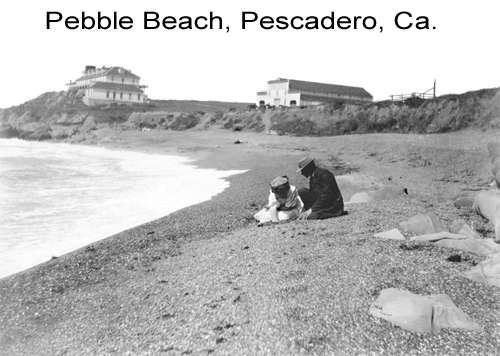
Loren also owned the delicious strawberry fields that bordered Pebble Beach-and when Coburn planted a fence around the fields and built a gate with a sturdy lock, he, in effect, declared war on both the locals and the tourists.
Sarah’s horse-and-wagons couldn’t go to Pebble Beach, and she couldn’t stop talking about it; she’d have to shut down the stable–and her loud and bitter complaints reached Loren Coburn.
Now that Coburn had a monopoly on the stable business in Pescadero, he said Sarah was unhappy because “She couldn’t go all over the country and do as she pleases.”
Sarah Swanton may have had little control over the livery stable market, but no one questioned her right to do as she pleased in her own hotel.
She ruled over the billiard room and the parlor, but most of all she was the culinary expert. Her breakfast menu included:
- Mutton Chops
- Beef Steak
- Mountain Chickens
- Strong Coffee with sweet milk
The Swanton House was “a plain country hotel with a good table” that once stood near the corner of what was called San Gregorio Street (now Stage Road.) Out in the street, in front of the hotel, stood the town’s revered flagpole–the stars hand sewn by the village’s matrons.
The flagpole also served as a significant marker to measure distance from the town to a neighbor’s house or a farm or a sawmill.
Known throughout California, the Swanton House was the place to stay, especially in the 1860s for those addicted to pebble hunting. It was a delightful hotel with an intimate setting. Name plates above the rooms called out herbs such as Fern, Myrtle, Rose, Elm, Ivy and Woodbine.
Sarah was born in Maine in 1825. She married Charles Swanton in the 1840s and the couple made their first home in Augusta, Maine where Sarah tapped her business acumen by operating a profitable millinery business until 1854. The hat business taught her how to please the fickle public.
She gave birth to two children, Eva and Frank. Husband Charles, an employee of the Lighthouse Board, predecessor of the Coast Guard, was sent to the West Coast, ending up in Pescadero (where some 10 years later a lighthouse was built at Pigeon Point.)
Sarah and the kids joined Charles in 1863, and together they opened the Swanton House. It was an overnight success, nurtured by the burgeoning popularity of that natural curiosity called Pebble Beach. And for San Franciscans, a new “get out of Dodge” place, no farther than a dusty seven hour stagecoach trip.
“…After a sound night’s sleep,” penned Howard Glyndon, the pseudonym for Santa Cruz writer, Mrs. Searling, “the calm stillness of the morning is only broken by the singing of the birds, the echoes of the gurgling waters in the creek, or the roar of the surf on the beach.”
Assisting Sarah was her lovely daughter, Eva, described by one male guest, “as a very agreeable aide.”
At the peak of its popularity, the Swanton House accommodated 150 guests, hosting weddings as well.
Sarah’s jaunty husband, Charles, was a one-man chamber of commerce who loved showing off the the natural curiosities of Pescadero. He particularly enjoyed escorting hotel guests on a private tour of the Pigeon Point lighthouse.
Charles Swanton’s Guided Tour:
500,000 bricks were used in the construction of the cone-shaped white tower.
On a clear day the white flashes are visible from the deck of a vessel 15 feet above the sea at a distance of 18 1/2 nautical miles.
The Swanton’s children did well in Pescadero. Eva wed local businessman Peter Stryker, and the couple later moved to San Francisco. In 1877 Sarah orchestrated son Frank’s* wedding at the hotel.
*[It's interesting June didn't mention the bride? Who was the bride? Tillie Lansdell was the bride! At the time June M. wrote this article, she didn't know that I knew the rest of the story! I knew my Cousin & step Great Grandfather was born in Pescadero in 1877! His Mother was Tillie Lansdell who Frank Swanton met in Watsonville. Living at the Swanton House according to the 1880 census and she’s listed there as Tillie Swanton! Clarence's (Bert) sister Eva Alice Swanton was born 1878? Tillie named her only daughter after Eva Stryker and the Alice middle name comes from Tillie's youngest Sister, "my" Great Grandmother on my Grandfather's side. Eva is buried in the Lompoc Cemetery with the Lansdell's. Number one plot of sixteen and "only" plot with a headstone and "only" Swanton in the Lompoc Cemetery!]
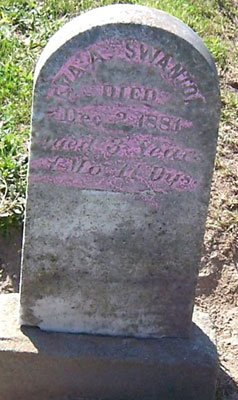
But, as in everybody’s life, tragedy eventually struck. Son Frank was 32 years old when he died of a heart attack. In the 1880s Charles showed signs of anxiety and mental distress; he was committed to the sanitarium at Napa, where he soon passed away.

[This maybe an issue, because Charles was listed in the 1901 S.F. register. with the same address as Tillie Swanton? Tillie maybe aided him out of sanitarium or something and then took care of him until he passed? He would have been 78]
As a widow and grandmother, the hotel became the focus of Sarah’s life. Then, in March, 1896, Sarah, who suffered from Bright’s (kidney) Disease, died in her beloved hotel.
[Grandmother of whom? Bert & Eva Swanton! Also note, Sarah died in the same year Lewis Meaney (my great Uncle) and his 3 cohorts came to Pescadero on their trip to Yosemite, uncanny? Keep in mind, Clarence would’ve been working around the livery stable. This is where they must have met and some twenty years later, Clarence would marry Lewis's Sister, Hattie]
Obits:
“The death of Mrs. Swanton removes one of the oldest and most highly respected and estimable members of the community.” –a San Francisco newspaper
Actual Obit: San Francisco Chronicle - 22 March 1896
PESCADERO March 6 Mrs C W Swanton one of the - pioneers of this place and well known throughout the county and State passed away at the Swanton House at 9 o’clock last night. She had for the last few months been troubled with Bright disease but her condition was not considered serious At 1 o’clock Mrs Swanton - was taken suddenly ill and in - a few moments expired. Mrs Swanton with her husband started the Swanton House In 1860 The hotel was one or the famous summer resorts of the State. CW Swanton died some eight years ago and since then his widow has conducted the hotel. Mrs Swanton was a woman of remarkable business ability affable in mantier and had few equals - as an entertainer. Her success In the hotel business was partly due to the courteous and accommodating way in which she treated her guests. The death of Mrs Swanton removes one of the - oldest and most highly respected and estimable members of the community. She leaves a daughter Mrs Stryker who lives In - San Francisco but was at her mothers bedside when she died. An only son died some years ago. She was a native of Maine and was upward of 70 years of age.
“…Although for the comfort and encouragement of the traveling public we must say her mantle has fallen on worthy shoulders of her only daughter, Mrs. Stryker takes charge.”–San Mateo newspaper
With Sarah Swanton’s passing, the Swanton House lost its magic spark and the hotel was sold. After that, innkeepers came and went. As the years passed, the neglected Swanton House failed to age with dignity.
The plain country hotel with a good table burned in the 1920s, in what could have been a case of arson, but no one was prosecuted.
The famous Pescadero hotel turned to ashes but Sarah Swanton’s legacy remains that of a willful, proud and productive woman.
* * *The End* * *
Should you have any questions about this reading, feel free to contact us using the links provided on this site? 360-779-2900
June 7, 1896
COBURN'S WHITE ELEPHANT.
A Big Hotel on Pebble Beach That Is Tenanted by Rats.
One of the largest and best appointed hotels ever built in California was put up by L. Coburn on Pebble Beach about two miles from Pescadero in San Mateo. That was over three years ago and the structure has not yet been thrown open to the public, but is standing alone in desolate grandeur, the home of bats and owls.
The reason the hotel has not been opened is due to a combination of circumstances capable of many different interpretations.
It is even wrapped up in the history of Pescadero. It seems that ever since the place was first laid out the people of the pretty little town nestling among the hills have looked upon Pebble Beach as part of their possessions. The land was of no use for agriculture, but the people made many trips to the place during the warm months of summer and got advantage of the sea breeze. San Mateo County supported the road, to it and in due time the citizens asked Congress to set Pebble Beach aside as a National park. This was no sooner done than Coburn stepped in tad said the land belonged to him, as he hid bought it many years ago as part of an old Spanish grant. Of course there was a big lawsuit, but Coburn went ahead and built his hotel, saying he was going to open it at once and kill the little town back in the hills. He won the suit against the Government, but found that he could not close the county road over the hills as it bad been a public highway for over twenty years. That is, he could not close it unless the road should not be used by anybody during a period of ten days.
The fight with the townspeople then commenced, and is still being waged relentlessly. A certain amount of all shore line, unless occupied by buildings, is public property, so Coburn could not keep the people off the pebble beach any more than he could keep them from using the road over the hills. He then built a road of his own, much longer than the old one, and invited the people to use it and let him close the old one.
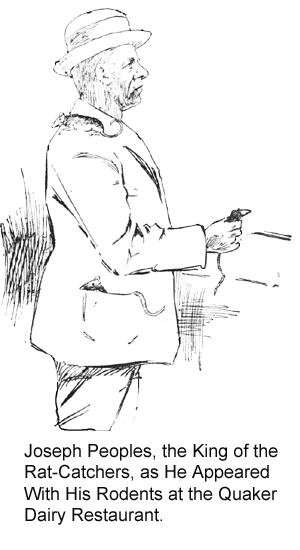
Mr. Coburn was asked if he would give the new road to the county if the people would give up the old one. This he refused to do, but said the people were welcome to use the new one as much as they liked. The people, however, decided that if Mr. Coburn would close one road he was likely to close another, and decided to hold on to what they had.
The fight has been going on now for nearly two years. Citizens of Pescadero positively refused to even walk over the new road. Each day Coburn's man closes the old road, but somebody from town goes out with an ax and cuts a passageway through, so that it is kept open constantly.
In the meantime Coburn is trying to get the Supreme Court to close the old road. So far he has failed, and declares he will not open the hotel until the people come to their senses. Mr. Coburn says the people of Pescadero are obstinate fools and the people say he wants to run the county.
The people along the coast who know anything about the hotel have named it "Coburn's Folly," and say that nobody" could live there if the place were opened in the grandest style. The surroundings are certainly bleak and desolate, except for perhaps a few hours during the warm days of summer.
The spot on which the hotel is built is about as inviting as Point Bonita as a place of permanent residence. Barren rocks line the shore and the hills back of the hotel are nothing but wild land.
The hotel is the only house for over a mile.
The hotel building is really a substantial and tasteful structure. It is three stories in height and contains over 200 rooms. A wide veranda runs all around the first floor, and the whole building is painted a pure white. The interior is quite pretentious. The halls are wide and the stairways are in hard wood. All of the rooms and good-sized, well lighted and supplied with pipes for hot and cold water. In fact, there is nothing lacking about the hotel to make it a modern caravansary. It is said to have cost $150,000.
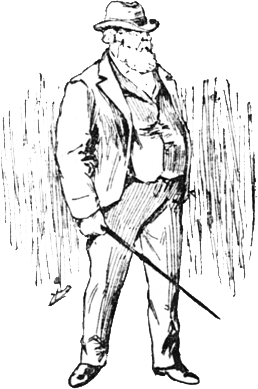
There is only one man in charge of the big and empty hotel. His name is Pat, and he says he is there to protect the property from being set on fire. His rooms are in the stables, but he patrols through the building at night and keeps a sharp lookout. It must be a most unpleasant job, for even in the daytime it almost gives one the shivers to walk through the echoing halls and hear the wind howling dismally and the melancholy beating of the waves on the beach. Many of the windows on the ocean side of the hotel have been broken by birds flying through them, and afterward nailed up with boards, This does not quite keep the wind out, and it sweeps through the halls and stirs up little eddies of dust. The sound of it through the upper part of the building is weird and ghostly, especially when mingled with the cries of some of the flying creatures that have made their homes there.
It would be sure death to bathe on the beach in front of the hotel as the swell is always very heavy. The beach is also covered with jagged rocks that rise from the sand only a few feet apart. But so that the guests could have the advantage of sea bathing Coburn built a dam across a creek over a mile from the hotel. His idea was to let it be filled when the tide came in and then close the floodgates, leaving a large lake that reaches far back into the hills. The place really would be most desirable for bathing, and if the hotel had been built near by there is no reason why it would not have made a most desirable summer resort.
***The End***
MORE ABOUT THE COBURN LEGACY
Loren Coburn and Joe Levy had been feuding for a decade. During the 1880s, Levy and his brothers, Armand and Fernand, had opened a general store in the old, two-story McCormick building, near the Swanton House, once a quaint hotel where Pebble Beach-bound guests often stayed overnight.
Not only did the Levy Brothers sell soft goods and hardware at the Pescadero location but there was a drug store, a Wells Fargo station, Western Union agency and a U.S. Post Office under the one roof. In 1885 Joe Levy was appointed the postmaster.
The warrant for Levy’s arrest was telegraphed to his Pescadero store. Before pleading, he was released on his own recognizance.
Joe Levy’s defense at the jury trial centered on the fact that people had traveled over the Pebble Beach’s cow trail for 20 years, conferring upon it the legal status of a public road. By locking the gate, Loren Coburn had obstructed and denied the public’s right to use the road. Levy contended that unlocking the gate amounted to appropriate legal action.
Following a tense trial, the jury agreed.
The local press reported that Pescadero residents traveled across the squiggly cow trail to Pebble beach where they held “mammoth picnics and seaside banquets” to celebrate Levy’s victory.
The verdict intensified competition between the millionaire landowner and the popular businessman. When Coburn launched the People’s Stage Line, a new stagecoach business covering the San Mateo-Half Moon Bay-Pescadero route, Levy countered with a rival line, setting off a cutthroat fare war.
[This maybe the stagecoach stories about Bert in his younger days. I know Frank was involved, as he traveled to Lompoc where Tillie Lansdell entered the picture? There are also stories about Sarah & Charles and their livery stable operations.]
In Half Moon Bay, Coburn was at a distinct disadvantage. The popularity of Levy and his brothers assured them of good contacts in the horse stable business; fresh horses, water and feed were always readily available for them.
Coburn became more stubborn and willful, barricading the Pebble Beach again. Charles Pinkham was equally committed to keeping the gate open. Widely publicized, the locking and unlocking of the gate led to a severe drop in tourists bound for Pescadero and its famous Pebble Beach.
In a change of strategy Coburn laid out a new, level road leading across his land to Pebble Beach–a road markedly superior to the bumpy old cow trail. Some locals wondered if the landowner had a change of heart; others knew Coburn better.
At the same time, the battleground switched to the floor of the state legislature. To protect their interests, Pescaderans asked Assemblyman John T. O’Keefe to introduce a bill dedicating Pebble Beach as a San Mateo County public park. O’Keefe did so, touting Pebble Beach as a great tourist resort, essential to Pescadero’s economic prosperity.
While the 1893 legislation passed both houses of the legislature, it failed to provide for a public road across Coburn’s land. To compensate, Pescaderans demanded that San Mateo County officials condemn a strip of Coburn’s land as a public road.
Despite the official dedication of Pebble Beach Park, Coburn hired carpenters to build his hotel and a horse stable overlooking the Pacific Ocean. Ignoring the legislation, he tacked up a sign proclaiming his new road to be private and locked the gate one more time.
While officials dealt with the murky legalities, Coburn made it clear he had no plans to dedicate his road to the county. Responding to voters’ complaints, the board of supervisors assigned County Surveyor Davenport Bromfield to survey the road situation at Pebble Beach in the fall of 1894.
Before Bromfield began the survey, Coburn’s sign and the locked gate led to one final bitter confrontation. To stymie travel to Pebble Beach, Coburn had his men dig a three-foot wide, three-foot deep trench on the other side of the gate.
These were emotional times for Loren Coburn: While warring with his neighbors, his wife, Mary Antoinette was dying of cancer in their ramshackle Pescadero home on San Gregorio Street.
Word leaked to Coburn that the Pescaderans were on their way. Confidently waiting at the gate, he blocked the entrance with his single-horse-drawn buggy.
Joe Levy arrived in his buggy.
Harsh words were exchanged, according to documents in the San Mateo County History Museum’s archives.
It was a standoff until Supervisor Henry Adair, accompanied by Road master Charles Pinkham and 20 men, as well as Adair’s rifle-toting teenage son, drove up in a large horse-drawn county wagon, equipped with a plow and a scraper. Besides reopening the gate, Adair planned to fill the trench with dirt.
In later court testimony, Coburn accused Adair of influencing people against him, also claiming that Adair swore to keep the gate open as long as he lived, whether in office or not.
The bitter struggle over Pebble Beach did not disappear. Coburn sued San Mateo County for damages, claiming his cattle had strayed as far south as Santa Cruz when the gate was opened. Restraining orders were issued, then reversed, with Coburn continuing to harass Pebble Beach’s visitors.
Rather than a dramatic bloody finale, the struggle over access to Pebble Beach sputtered out.
Today beach-goers can enjoy its wonders without worrying about a locked gate.
SAN FRANCISCO, SAN MATEO AND SANTA CRUZ RAILROAD,
[San Mateo Gazette, 1 Apr 1876.]
L. H. Shortt, engineer, has issued his report on the above railroad, it pamphlet form, stating the results of his survey, a description of the route selected, an estimate of the cost and a brief statement of the resources of the section of country through which it will pass.
He divides the survey into three sections; first from San Francisco to Halfmoon Bay, the second from thence to Pescadero, the third from the latter place to the line between San Mateo and Santa Cruz counties of the first section he says there are two routes favorable to the construction of the road, one running through the an San Andreas Valley and down the Pilarcitos Creek, the other keeping near the shore line of the ocean. As to which of these is the most feasible, likely to be the most profitable, or where or how the selection between them may be made, the report is entirely silent.
The second division from Halfmoon Bay to Pescadero is nineteen miles in length. Commencing at the intersection of Coreas and Ocean streets, in the town of Halfmoon Bay, the line runs west of the county road, over the lands of Ames, Sellick, Gonzales: crosses the county road, the lands of R. H. Hatch, recrosses to the west of the county road, runs through the lands of H. bobble, Butts, Frey, Martln, Garrigan, O'Conner, Potter, Gordon; takes to the east of the county road to cross Tunitos Creek, and then turns to the west side of the county road again, passing over lands of Dwyer and Gordon, Lautenschlager, Mrs. Moore, Quinton ; crossing the county road again, 500 feet north of the San Gregorio Hotel, and after crossing San Gregorio Creek east of the town, cuts the lands of L. Dale, goes over to the west of the county road again, then through the lands of S. W. Prebble, H. E. Osgood, Thomas Hillis, T. W. Moore; passing to the east of the county road near the place known as the milk ranch, near the foot of the Tom Moore Hill; then over the lands of Alexander Moore back to the west side of the county road, running through the land of Orrin Brown, B. Weeks, B. R. Weeks, entering Pescadero near the old flag staff; crosses the creek at a point 300 feet east of the Pescadero House, crosses the street, enters lands of B. Weeks, William Knapp, and crosses Main street about halfway between Stryker & Co.'s store and the hills, where it reaches the depot grounds, nineteen miles from the starting point at Halfmoon Bay. The Third Division commencing there, on the lands of B. Weeks, crosses the lands of L. Chandler, Butano Creek, the county road; passes around the hill there on the north and west side to get to the higher land near the ocean beach; follows closely the shore line crosses Arroya Frijoles, or "Bean Hollow"; crosses to the east of the county road near Yankee Jim Hollow, and runs on that side until it reaches Pigeon Point, thence to Gazos Creek ; from Butano to Gazos the line runs nine and one fourth miles, all the way, on lands of Clark & Coburn ; crossing the Gazos it passes over the lands of Ramsey, R. II. Brown, crosses White House Creek, lands of R. E. Steele about half way between the foot of the mountain range and the ocean shore, crosses the lands of I. C. Steele, and reaches the lands of the late S. J. Finney. From there to the county line the route will not be located until it is determined where it will run beyond in Santa Cruz county.

The road will pass around the high cliff immediately south of Gordon's chute, about 100 feet below the summit and 125 feet above the water. At the highest land between the Tunitos and the and the San Gregorio creeks, a similar line is taken, the ridge being at that point 400 feet high near the water's edge. Here are two tunnels, each 175 feet In length, the first on the route. Shortly after leaving San Gregorio occurs the third tunnel 250 feet long, and the fourth and last is under the Torn Moore Hill, and is 2,000 feet in length, about 250 feet below the summit. At the Arroyo An Nuevo, on the lie between I. C. Steele and the lands of the late S. J. Finney, the point of suspending the survey, the distance is 14 ½ miles from Pescadero and 33 ½ miles from Halfmoon Bay. The steepest grade on the road will 95 feet to the mile in descending the Tom Moore Hill into the Pescadero Valley.
The estimate of the cost of putting he road in running order is as follows: Grading, $252,199 50; wood work, $160,363 20 ; superstructure, rack, switches, etc.,$253,475 00; superintendence and contingencies, $25,000 00; total, $771,337 70. Cost per mile road bed $12,763 00; road be and superstructure, $20,478 70; total cost per mile, $23,025 00. This estimate is based upon building a road first class in all respects, on the narrow or three foot gauge.